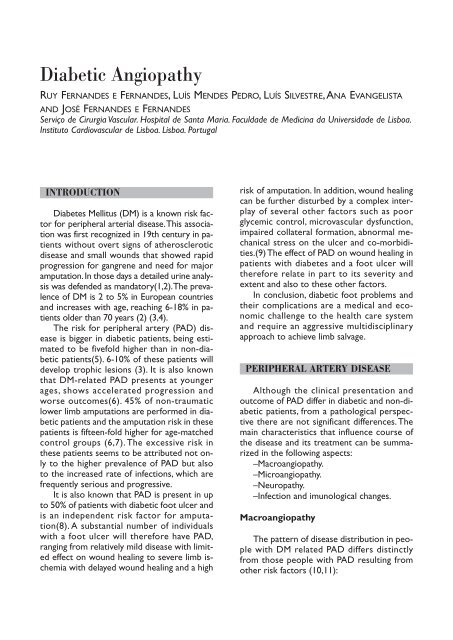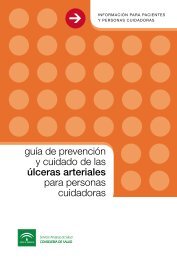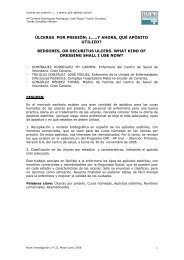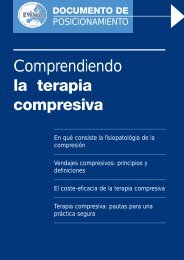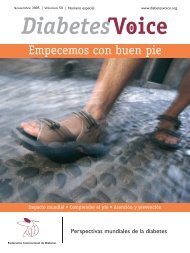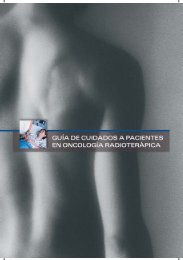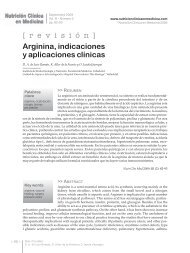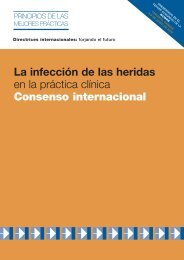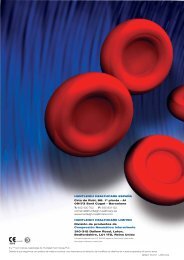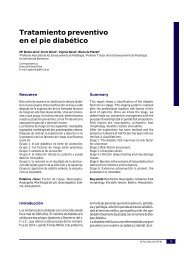Descargar - Úlceras.net
Descargar - Úlceras.net
Descargar - Úlceras.net
- No tags were found...
Create successful ePaper yourself
Turn your PDF publications into a flip-book with our unique Google optimized e-Paper software.
Diabetic AngiopathyRUY FERNANDES E FERNANDES, LUÍS MENDES PEDRO, LUÍS SILVESTRE, ANA EVANGELISTAAND JOSÉ FERNANDES E FERNANDESServiço de Cirurgia Vascular. Hospital de Santa Maria. Faculdade de Medicina da Universidade de Lisboa.Instituto Cardiovascular de Lisboa. Lisboa. PortugalINTRODUCTIONDiabetes Mellitus (DM) is a known risk factorfor peripheral arterial disease. This associationwas first recognized in 19th century in patientswithout overt signs of atheroscleroticdisease and small wounds that showed rapidprogression for gangrene and need for majoramputation. In those days a detailed urine analysiswas defended as mandatory(1,2). The prevalenceof DM is 2 to 5% in European countriesand increases with age, reaching 6-18% in patientsolder than 70 years (2) (3,4).The risk for peripheral artery (PAD) diseaseis bigger in diabetic patients, being estimatedto be fivefold higher than in non-diabeticpatients(5). 6-10% of these patients willdevelop trophic lesions (3). It is also knownthat DM-related PAD presents at youngerages, shows accelerated progression andworse outcomes(6). 45% of non-traumaticlower limb amputations are performed in diabeticpatients and the amputation risk in thesepatients is fifteen-fold higher for age-matchedcontrol groups (6,7). The excessive risk inthese patients seems to be attributed not onlyto the higher prevalence of PAD but alsoto the increased rate of infections, which arefrequently serious and progressive.It is also known that PAD is present in upto 50% of patients with diabetic foot ulcer andis an independent risk factor for amputation(8).A substantial number of individualswith a foot ulcer will therefore have PAD,ranging from relatively mild disease with limitedeffect on wound healing to severe limb ischemiawith delayed wound healing and a highrisk of amputation. In addition, wound healingcan be further disturbed by a complex interplayof several other factors such as poorglycemic control, microvascular dysfunction,impaired collateral formation, abnormal mechanicalstress on the ulcer and co-morbidities.(9)The effect of PAD on wound healing inpatients with diabetes and a foot ulcer willtherefore relate in part to its severity andextent and also to these other factors.In conclusion, diabetic foot problems andtheir complications are a medical and economicchallenge to the health care systemand require an aggressive multidisciplinaryapproach to achieve limb salvage.PERIPHERAL ARTERY DISEASEAlthough the clinical presentation andoutcome of PAD differ in diabetic and non-diabeticpatients, from a pathological perspectivethere are not significant differences. Themain characteristics that influence course ofthe disease and its treatment can be summarizedin the following aspects:–Macroangiopathy.–Microangiopathy.–Neuropathy.–Infection and imunological changes.MacroangiopathyThe pattern of disease distribution in peoplewith DM related PAD differs distinctlyfrom those people with PAD resulting fromother risk factors (10,11):


